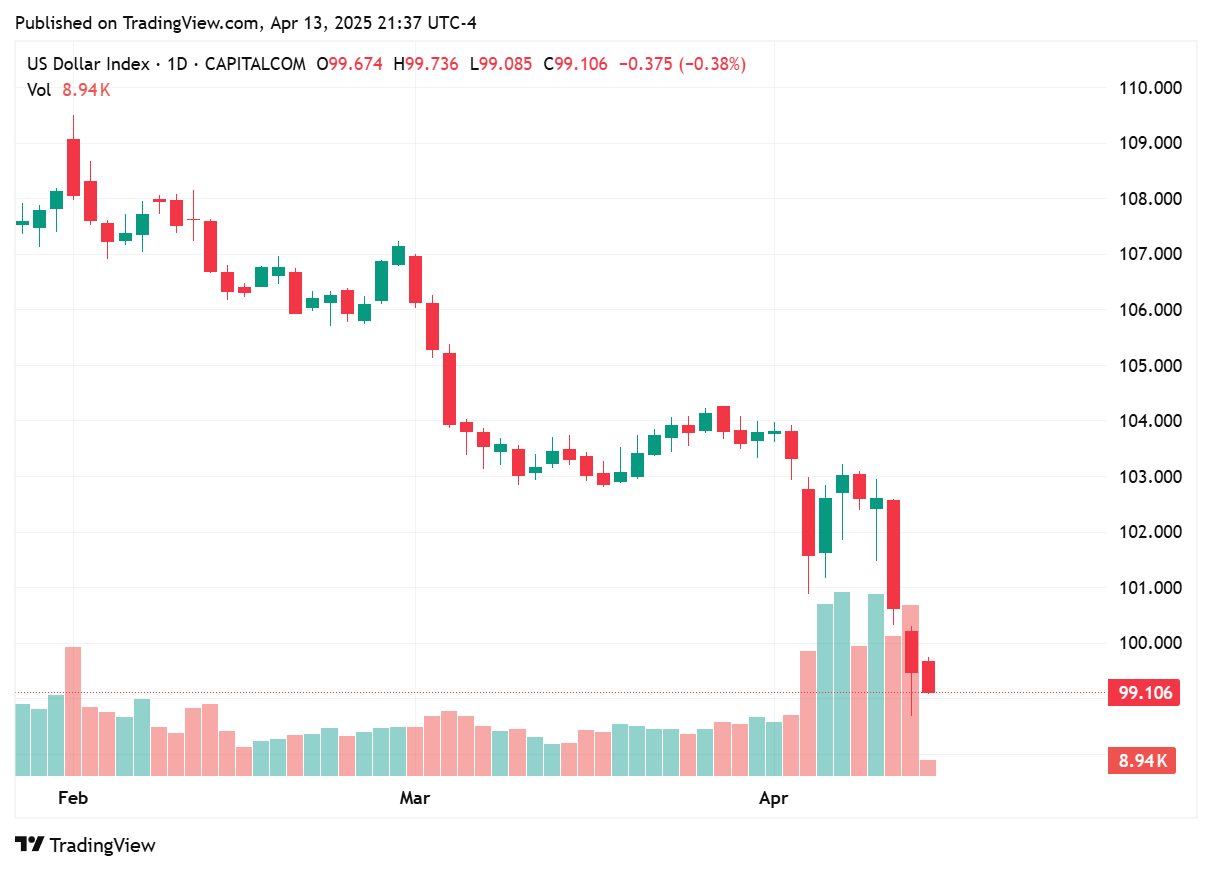Week 15 (April 7-April 13, 2025)
Dear readers,
The week was marked by significant fluctuations in stocks, bonds, and currencies, primarily driven by President Trump's tariff announcements and subsequent policy reversals.
The U.S. economy is currently grappling with heightened uncertainty, driven by a combination of policy shifts, trade tensions, and inflationary pressures.
The annual inflation rate in the United States eased to 2.4% in March 2025, down from 2.8% in February, marking the lowest level since September 2024.
While inflation has cooled, mounting tariff pressures from recent policy changes could reverse this trend in the coming months, particularly impacting energy and consumer goods prices.
The U.S. Dollar Index (DXY), which measures the dollar against a basket of major currencies, fell below 100 this week, reaching its lowest level in three years.
The weakening dollar reflects broader concerns about U.S. economic policies and global confidence in its financial system. The decline in the dollar increases the cost of imports, potentially fueling inflation at a time when consumer sentiment is already weak. Reduced capital inflows into U.S. markets could lead to further declines in equities and bonds, compounding economic instability.
On the other hand, a decrease in the U.S. dollar's value will make American exports more competitive and affordable in the global market.
U.S. consumer sentiment deteriorated sharply in April, reflecting widespread economic concerns fueled by escalating trade tensions and inflation fears. The University of Michigan Consumer Sentiment Index dropped sharply to 50.8 in April, down from 57.0 in March, marking an 11% monthly decline and the lowest level since June 2022.
Our primary outlook anticipates a mild recession, driven by the significant uncertainty and rising costs associated with the ongoing tariff war.
We believe the market is currently in a bearish phase. The current rally is an intermission driven by deeply oversold conditions. Another decline, is likely ahead and may result in a lower low.
BOND MARKET
The bond selloff signals a disruption in the traditional relationship between stocks and bonds, with both asset classes falling at the same time—an uncommon event usually observed during times of significant uncertainty.
The yield on the benchmark 10-year U.S. Treasury spiked dramatically, rising from 4.01% at the start of the week to 4.58% by Friday, marking its steepest weekly increase since November 2001.
This surge was triggered by President Trump's tariff announcements, including a 145% tariff on Chinese imports, which stoked fears of inflation and recession.
Investors withdrew $25.71 billion from global bond funds, the largest weekly outflow in over five years, as even traditionally safe assets like U.S. Treasuries faced selling pressure. Several factors are influencing the situation, but with trade relations deteriorating between the U.S. and China, the U.S. trade deficit is expected to shrink significantly. This will leave China with hundreds of billions of dollars less each year to reinvest in the U.S., including in Treasury bonds. Currently, China is the second-largest foreign holder of U.S. Treasury bonds, following Japan.
Rising yields reflect declining bond prices, as investors sold off bonds amid concerns about geopolitical instability and skepticism over U.S. financial policies.
GOLD
Gold climbed steadily throughout the week, reaching $3,236.06 per ounce on Saturday, April 12, marking a weekly gain of over 2.5%. The surge is attributed to heightened investor demand for gold as a safe-haven asset. Gold has appreciated by over 18% in 2025 and nearly 32% year-over-year, reflecting strong bullish momentum fueled by geopolitical uncertainty and expectations of Federal Reserve rate cuts.
OIL
Crude oil prices declined slightly during the week, closing at $61.54 per barrel. This marked a year-to-date drop of around 16%, reflecting ongoing concerns about global demand and geopolitical tensions and changes in production policies by OPEC+. OPEC+ announced plans to accelerate production increases starting in May instead of July, contributing to rising supply amidst weakening demand. Over the past week, oil prices declined by over 10%, with Brent and WTI reaching their lowest levels since 2021.
Oil prices are dropping below the break-even levels for many producers, which could lead to bankruptcies in the medium to long term—a troubling situation.
FED
Boston Federal Reserve President Susan Collins stated that tariff-driven inflation could push core PCE inflation above 3% in 2025, with most of the effects likely occurring this year. She estimated that tariffs could raise price levels by 0.7 to 1.2 percentage points, impacting both directly consumed imported goods and imports used in domestic production.
Indices
S&P 500: Experienced significant volatility. It surged by 9.5% on Wednesday, marking its best single-day performance since 2008, but later fell by 3.5% on Thursday. By the end of the week, it recorded a weekly gain of 5.7%.
Nasdaq Composite: Saw a similar pattern, with a 12.2% surge on Wednesday (its largest gain since 2001) followed by a drop of 4.3% on Thursday. It ended the week up by 7.29%.
Dow Jones Industrial Average: Rose by nearly 7.9% on Wednesday, its best performance in five years, before dropping 2.5% on Thursday. The Dow finished the week with a gain of 4.95%.
Russell 2000: Smaller-cap stocks faced declines during the week, with the index falling by 4.3% on Thursday. The Russell 200 finished the week with a gain of 1.82%.
OUR TRADES
On Friday, we reduced our long ETF positions by half.
Upgrade to a paid subscription to unlock access to detailed entry and exit points for our trades, real-time trade updates, and expert insights into macroeconomics and finance. Subscribers will also gain exclusive access to advanced options trading strategies and the methodologies behind structuring these trades.



